Experience Jebel Akhdar
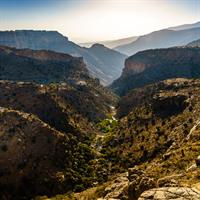
Overview
Situated at the top of the Hajar Mountain range, Jebel Akhdar, which means “Green Mountain” in Arabic, is in a unique location 6,560 feet above sea level where it receives enough rainfall to support local agriculture - crops of pomegranates, apples, apricots, figs, pears, plums, almonds, walnuts, and olive trees. It is considered by many, especially the locals, as one of the top things to do in the Sultanate. The mountain range is dotted with Omani villages, wadis, agricultural terraces, and stunning mountain views.
Jebel Akdar is also famous for the Damask roses that cover the mountain slopes in large swaths of pink throughout April and May. These Damask rosed are distilled to make Omani rose water – a staple in every Omani household for fragrance, culinary, and medicinal purposes.
The mountains are one of the most stunning places to visit in the Middle East, offering jaw-dropping mountain views, adventure travel, and rich cultural experiences. The old villages, canyons, and terrace plantations are a huge draw and also why the Jebel Akdar mountains have become a top tourist destination for foreigners and locals alike.
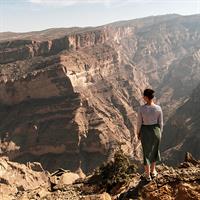
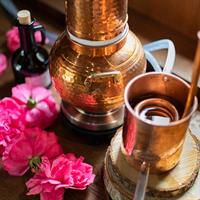
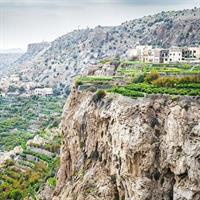
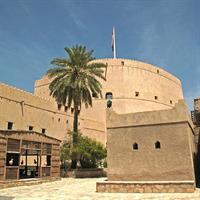
Things to See and Do
Hiking, Trekking, and Nature Walks: Explore the rugged terrain and scenic trails of Jebel Akhdar. The various routes cater to different levels of expertise offering stunning views of the surrounding valleys and villages. A hike along a wadi to explore the abandoned settlements while learning about the local plants, endemic animals, and witnessing life in local communities is a great way to spend the day.
Fruit Orchards: Jebel Akhdar is famous for its terraced orchards, particularly for its pomegranates, apricots, and roses used for rose water. Visitors can tour these orchards, learn about local farming practices, and even participate in fruit picking during the harvest season.
Rose Water Distilleries: Jebel Akhdar is renowned for its rose water production. Visitors can learn about the traditional methods of distillation and purchase authentic rose water and other local products.
Al Hoota Cave: Just a short drive from Jebel Akhdar is the vast cave system of Al Hoota. Here you’ll find impressive stalactites and stalagmites, underground lakes, and unique limestone formations. This is definitely worth a visit.
Stagazing: Due to its remote location and minimal light pollution, Jebel Akhdar offers excellent conditions for stargazing. Be awed at the clear night sky and observe celestial bodies with the naked eye or through telescopes.
Culture: Interact with the friendly locals, learn about their customs and traditions, and perhaps even participate in local festivals or celebrations if your visit coincides with any cultural events.
Villages: Overall, there are about 58 villages scattered around Jebel Akhdar. Visiting these villages offers the opportunity to experience the traditional way of life in the Omani mountains. A convenient and popular trekking route laces together three picturesque mountain villages of Al Aqr, Al Ayn, and Ash Shirayjah. You can interact with local residents, learn about their customs and traditions, and admire the architecture of the old stone houses.
Nizwa Fort and Nizwa Souk: Considered the birthplace of Islam in Oman and once it’s capital and a major center of trade, religion, and exploration. Nizwa Fort is the largest fort in the Arabian Peninsula. You can explore the maze of rooms and climb to the top of the tower to enjoy a 360-degree view of Nizwa.
The Nizwa Souk is famous for its Bedouin silver jewelry and vendors sell fresh produce, spices, pottery, and leather goods.
Jabreen Castle: The Jabreen Castle was built in 1670 as a palace for the Iman and his family. It is three stories tall, features two towers, numerous reception halls, dining area, meeting rooms, a court room, a libray, and classrooms. Admire the Omani craftmanship found in the castle’s fascinating ceiling murals, beautifully carved doors, and the Arabic calligraphy and frescoes that adorn its walls.
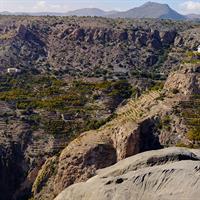
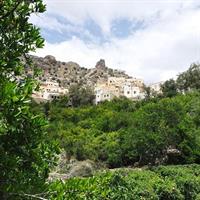
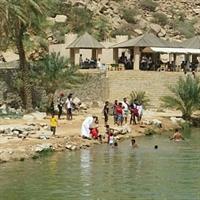
Highlights
Diana’s Viewpoint: Named after the late Princess Diana who visited this vista by helicopter for one afternoon in 1986, this stunning viewpoint is a must visit. At over 6,500 feet above sea level the panoramic views of the surrounding valleys, terraced fields, and rugged cliffs are breathtaking.
Village of Al Aqor: This tiny village sits on the edge of a cliff, below Dian’s Viewpoint on the Saiq plateau. The village grows a several vegetables and fruits, as it is kept fertile by wanted that flows along ancient irrigation channels know as aflaj. A walking path through the Jebel Akhdar is the only way to get here, it is not possible to drive into the village.
Village of Ash Shuraiqa: This village is linked to neighboring villages by the irrigation channels that keep the terraces watered. Here you’ll find the pink Damask roses that bloom each spring. The village is situated at a perfect vantage point over Wadi Muaydin many feet below, making it a sought after spot for photographs. This is also a great area to take in the local culture and hospitality.
Wadi Bani Habib: This picturesque wadi (valley) is renowned for its stunning natural beauty, including terraced fields, lush greenery, and traditional Omani villages. An easy walking path leads down 200 steps to the wadi bottom, across the irrigation channel that keeps the orchards fertile, and up to the cluster of decaying mud buildings on the other side. The entire area boasts a diverse ecosystem with a variety of flora and fauna, making it a haven for nature enthusiasts. The entire area is breathtaking.
Village of Seeq: This small village has a rose-water distillery, making it an interesting place to learn about the production of rose-water. It is also a trailhead for the Village Trail.